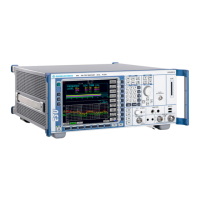Operating Manual 1302.6163.12 - 03 4.67
R&S ESU Instrument Functions
Receiver Mode
ADD TO PEAK
LIST
The ADD TO PEAK LIST softkey adds the frequency of the current marker to the
peak list (see also section “Data Reduction and Peak List” on page 4.33).
Remote command: --
TUNE TO
MARKER
The TUNE TO MARKER softkey sets the receiver frequency to the marker fre-
quency.
Remote command: :CALC:MARK:FUNC:CENT
MARKER
TRACK
The MARKER TRACK softkey couples the current receive frequency to the marker
frequency.
Remote command: :CALC:MARK:COUP ON
MKR−>TRACE
The MKR−>TRACE softkey places the marker on a new trace. The trace is selected
via a data entry field. Only those traces can be selected which are visible on the
screen in the same window.
The function of the softkey is identical to the MKR−>TRACE softkey in the
MKR FCNT and MKR menu.
Example:
Three traces are presented on the screen. The marker is always on Trace 1 on
switching on.
[MKR ->TRACE] "2"
The marker jumps to Trace 2 but remains on the previous frequency or time.
[MKR ->TRACE] "3"
The marker jumps to Trace 3.
Remote command: CALC:MARK1:TRAC 1
CALC:DELT:TRAC 1
MKR−>
STEPSIZE
The MKR−>STEPSIZE softkey sets the step size for the receiver frequency variation
to the current marker frequency, and also sets step size adaptation to MANUAL.
STEPSIZE remains at this value until the receiver frequency entry mode in the
STEPSIZE menu is switched from MANUAL to AUTO again.
The MKR−>STEPSIZE function is, above all, useful in the measurement of harmon-
ics.
Remote command: CALC:MARK:FUNC:CST
MIN
The MIN softkey sets the active marker to the minimum value on the corresponding
trace.
Remote command: CALC:MARK:MIN
CALC:DELT:MIN
NEXT MIN
The NEXT MIN softkey sets the active marker/delta marker to the next higher mini-
mum of the selected trace. The search direction is defined in the NEXT MODE sub-
menu (see below).
Remote command: CALC:MARK:MIN:NEXT
CALC:DELT:MIN:NEXT

